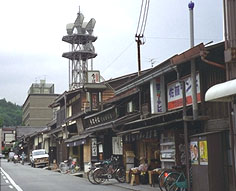
Bruce "Tog" Tognazzini.
|
|
Japan on $1000 per Day
Day 8: Country Inn at Big City PricesWe are standing on the bullet train platform at Okayama when we notice something strange about the tracks. There are four sets of tracks, the ouside pairs for local trains that stop for passengers, and two sets of tracks in the middle for North- and South-bound express trains. What seemed strange was that these middle tracks were banked at a really serious angle, particularly when you consider the station was straight enough that we hadn’t at first even noticed a curve at all. It seemed really excessive to have the track at such a steep incline unless the express trains came through the station at such a high speed that.... Whoommmppp. Whoooooooooooooooooooooosh. Have you ever practically been blown off a platform by a train coming through a busy station at 235 MPH? No? Then you probably haven’t achieved a heart rate in excess of 300 beats per minute. It’s quite exhilarating, really. This scheme wouldn't work in the USA. Everybody would be out on the tracks. Little kids. Mothers in hot pursuit. Aging hippies demanding their right to sit anywhere they please. "Suits" in need of shaving thirty seconds off their between-meeting time. All these and more would be routinely mowed down by fast moving-trains, with whatever remnants their relatives could assemble appearing in court to get their 10 million dollar payouts from the railroads. Even though we were Americans, we elected to remain on the platform until our train came to a full stop. Once aboard, we sampled the train cuisine: the ever-present bento boxes, wheeled through the cars by young women every two or three minutes, or so. The food was cold, but very attractive and quite tasty (American Airlines, whose Japanese cookin' I mentioned in Day 1, was not involved in this cuisine). After lunch, my anxiety level began to rise. Once we reached Nagoya, unfamiliar to us, we would have exactly 13 minutes to transfer to our train to Takayama, our day’s destination. Considering our experiences in Tokyo Station, I couldn’t see how it could be done, but Julie did it, using the now-patented Doctor Julie Moran Japan Train Station Methodology. It is really quite simple: you find anyone in any uniform of any sort and hold your train tickets up to them while looking around with a bewildered look on your face. It requires only 1.7 such manoeuvres to be on your way to the very platform you need. We transferred trains with five minutes to spare. Takayama, nestled in the mountains, sports the required amount of neon and plastic, but still retains several square blocks of the one and two story shops and houses of wood darkened by the ages. It is a side trip well worth taking. We stayed in a 150 year-old ryokan, a Japanese country inn, by the name of Kinkikan. It was a delight. When we first arrived and had slipped off our shoes, we were guided to our private room, consisting of eight six-foot by three-foot tatami mats, where we were immediately served tea. Then we were off on foot to visit two old merchants’ mansions that lie side-by-side near the river. The houses were beautiful examples of fine wood craftsmanship, and we were both quite willing to immediately move in on a permanent basis, even if it did mean sitting on the floor. We found in one of the display houses a fascinating placard explaining "the three miracles." It seems that during a single year in the 1950s, television, refrigerators, and washing machines all arrived in Japan. (Julie and I are at odds as to exactly what year the placard said it was.) Exactly how this simultaneous miracle occurred was not mentioned at all. My conjecture was that the government decided to radically increase Japan’s power generating capacity in order to make such devices practical for the first time. Once the power was there, people bought. Julie’s conjecture was that the Japanese, as they are known to do, all simultaneously decided that these items were must-haves and all went out on the same day and bought them. (Japan is notorious for engaging in fads with a frequency and at a scale undreamed of in the West.) The answer awaits further research—or perhaps an explanatory email from one of you. When we returned to our 8-tatami living room (rooms in Japan are measured in the number of standard tatami mats it takes to cover the floor), we changed into our yukatas—long cotton bathrobes similar in cut to kimonos—then headed out to the elevator to the top floor where we would separate to go into the his and hers public baths. Fortunately for me, Julie looked down just before we got aboard and noticed my slippers.
It is in the poorest possible taste to wear these slippers out of the toilet and into your room. It is even worse to be standing in front of the elevator wearing them, as I was then. Once I had changed out of my latest faux pas into the proper slippers, we retired to our separate, but equal public baths, where we (separately but equally) bathed with a couple from Kobe, vacationing in this arctic region of Japan where it was actually a few degrees below 100. The bath held a sweeping view of the city and the alps beyond. It was a thoroughly pleasant way to end a day. When we returned to our room, we were served a veritable banquet. Dish after dish kept arriving. When we were so stuffed we could only lay on the floor mats and groan, our maid shooed us out of our 8 tatami living room so she could transform it into our 8 tatami bedroom. We took this opportunity to slip out for a walk along the street, clad only in our wooden clogs and yukatas. Our guidebook had made much of this wide-spread Japanese tradition, but it seemed that in all of Takayama, said tradition was being practiced only by a couple of foolish-looking gaijin over by Kinkikan. What made the whole thing particularly silly were the crowds of teen-age kids in short skirts and black leathers going into The Honky-Tonk Disco Club, immediately next door. We walked, nonchalantly, as far as the corner, where it was quite obvious things were not going to get better, then slunk back to the ryokan, trying to pretend we walk around the streets in our bathrobes all the time back home. Back in our room, we found our futons prepared, and a small door now open in the ancient Japanese tonsu topped by our TV set. Inside were a multitude of Japanese movies of an adult nature, with dubious story lines but excellent production values. They had thought of everything, including the little coin slot beside the VCR. 100 yen ($1.00) for 10 minutes. After paying $600 for a night’s lodging (meals included), dropping "silver dollars" in a coin slot every few minutes didn’t seem like such a big deal, and we were here, after all, to absorb the full Japanese experience. After completing our research, we popped in our earplugs to attenuate the quiet strains of the disco music pulsating through the walls from the Honky-Tonk next door, then drifted off to sleep. Hi Tog, |


